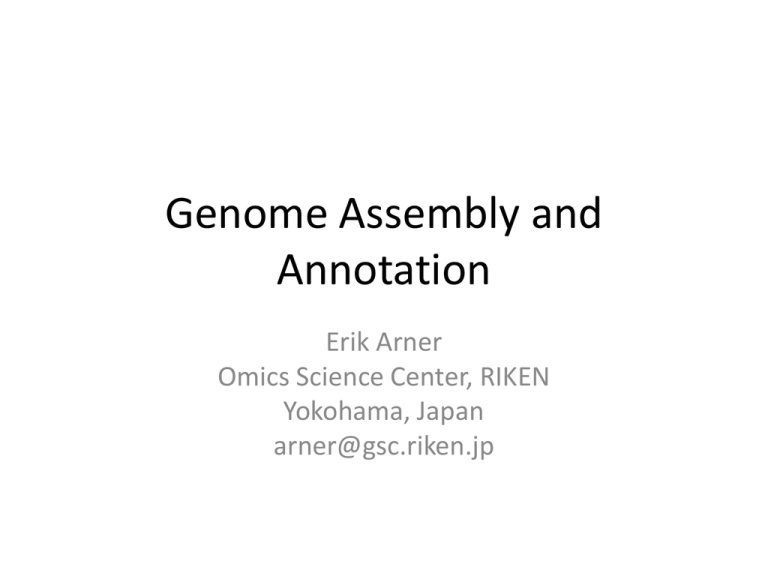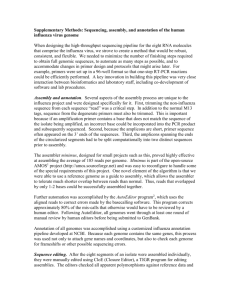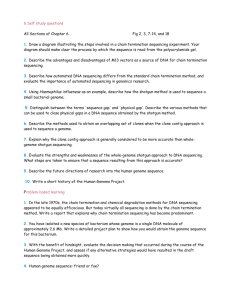Genome Assembly and Annotation
advertisement

Genome Assembly and Annotation Erik Arner Omics Science Center, RIKEN Yokohama, Japan arner@gsc.riken.jp NCBI Map Viewer NCBI Map Viewer Entrez Gene Entrez Gene Entrez Gene Entrez Gene Aims of lecture • How was the human genome put together – Limitations • What is in the genome and where is it? – Genes, SNPs etc • Databases – GenBank → RefSeq → Entrez Gene • This lecture is focused on NCBI resources – UCSC, Ensembl etc use similar methods • Genomics ↔ bioinformatics Outline • Genome assembly – Basics of shotgun sequencing and assembly • Clone-by-clone • Whole Genome Shotgun – Current status of human reference genome • Genome annotation – Placing genes on the genome • Known mRNAs • Predicted genes – Other features • SNPs Basics of shotgun sequencing • Problem: with current sequencing technology, the longest continuous sequence that can be reliably determined is around 800 – 1000 nt – Human genome contains ~ 3 billion bases • 50 – 250 Mb chromosomes • Novel technologies will produce longer sequences (several kb), however: we will not be able to sequence millions of bases anytime soon • Solution: shotgun sequencing – Sanger 1980, still state of the art – Divide and conquer – Puzzle Basics of shotgun sequencing Target sequence - UNKNOWN Amplification Random shearing Cloning, sequencing, and base calling Detection of pairwise overlaps Assembly → Contig Consensus Basics of shotgun sequencing Unordered contigs Finishing Basics of shotgun sequencing • Main problems – Contamination • Vector sequences • Bacterial genome (from amplifying clones in bacteria) • Other projects being sequenced – Polymorphisms • Haplotype expansion (two alleles represented as separate loci) • Missing allele (unplaced contig) – Repeats • Component mis-assemblies • Path level mis-assemblies – Non-overlapping contigs appear to overlap Basics of shotgun sequencing False overlap! Assembly Erroneous assembly! Consensus Erroneous consensus! Basics of shotgun sequencing R1 R2 R3 R2 R3 R2 R3 R1 R2 ? ? Basics of shotgun sequencing • Finishing – Major part of sequencing project • Finishing of human genome still ongoing • 50% of time and money spent on finishing – Repeats major reason for long and expensive finishing process Basics of shotgun sequencing • Two major strategies for shotgun sequencing of whole genomes – Clone-by-clone • Hierarchical • Minimal set of overlapping clones selected for sequencing • Overlapping segments sequenced separately, then merged – Whole Genome Shotgun (WGS) • Everything at once Basics of shotgun sequencing Basics of shotgun sequencing • Clone-by-clone – Advantage: problems stay local – Disadvantage: difficult to coordinate, lots of pre-processing and infrastructure needed • WGS – Advantage: pre-processing step eliminated • No clone mapping, coordination etc – Disadvantage: problems go global • Public genome initiative used clone-by-clone strategy, private used WGS • Merits heavily debated, combination might be preferable Current status of human genome • Essentially finished …or? – 234 gaps remain in euchromatic part of genome • 17 million bases (0.5%) • Centromeres and telomeres not sequenced – Will require new technology – ~ 45% of the human genome consists of repeats interspersed with non-repetitive sequences • Transposon derived (LINEs, SINEs) • 3 – 4% segmental duplications (> 1kb, > 90% similar), ~ 40% believed to be misassembled • Multi-gene families – Large number of anonymous donors for HGP, but much of the DNA comes from one individual • Individual structural variants – Duplications, deletions, inversions, translocations… NCBI Map Viewer NCBI Map Viewer Genome annotation • Placing the genes – Aligning RefSeqs – Prediction • Using additional transcript information (GenBank) • Ab initio – Gene assignment • SNPs • MUCH more not covered in this lecture – Predictions using bioinformatics – Alignment of other types of data Detour: GenBank vs RefSeq • GenBank: – Archive of primary sequence data • mRNA, genomic DNA (may include genes), non-coding RNA (rRNA, tRNA, miRNA…) – Not curated (basic quality checks) – Sequencing performed by submitter • Only submitter can update records (annotation etc) – Multiple entries for same locus – Data exchanged with EBI/EMBL and DDBJ – Data from more than 260 000 species (Jan 2008) Detour: GenBank vs RefSeq • RefSeq: – – – – “GenBank de luxe” Curated collection of DNA, RNA, and protein sequences Built by NCBI Only “major”/”model” organisms for which sufficient data is available • More than 5000 organisms (March 2008) – One example of each natural biological molecule • One good example from GenBank • Combination of GenBank entries • Imported from other curated databases – SGD (Yeast), FlyBase (Drosophila) Detour: GenBank vs RefSeq GenBank RefSeq Not curated Curated Author submits NCBI creates from existing data Only author can revise NCBI revises as new data emerge Multiple records for same loci common, Single records for each molecule of records can contradict each other major organisms No limit to species included Data exchanged among INSDC members Limited to model organisms Akin to primary literature Akin to review articles Exclusive NCBI database Genome annotation • Aligning RefSeqs to genome – mRNAs, non-coding RNAs – SPLIGN • BLAST + dynamic programming – Heuristics (e.g. splice signals) included – Attempts to use as little a priori information as possible (codon usage, polyA signals) – Alternate RefSeq derived models sharing one or more exons on same strand are grouped under the same gene – Requirements for gene annotation • Defining RefSeq transcript alignment is >=95% identity • Aligned region covers >=50% of the length, or at least 1000 bases – RefSeqs aligning to multiple genomic locations • Best alignment selected and annotated • If they are of equal quality, both are annotated – Arbitrary parameters! – Gene MODELS! Genome annotation • Prediction – Gnomon • HMM based on transcript and protein alignment data, heuristics • Goal: to ensure that if a biological expert is presented with the same data, they could not produce an obviously improved gene model Genome annotation • Gnomon – Additional GenBank mRNAs and ESTs aligned to genome using SPLIGN – Combined with RefSeq alignments → clusters – Additional information used (e.g. codon usage) – BLAST (translated nucleotide against protein db) hits incorporated, including hits in other organisms • Frameshifts/stop codons → pseudogene candidates – HMM generated, used for ab initio prediction • Ab initio models blasted against protein db, HMM updated iteratively – Resulting models included in annotation • Only models not overlapping with RefSeq based models Genome annotation • SNPs – dbSNP – Mapped to genome using BLAST • High/low confidence – High: 95% of the flanking sequence aligns with 0-6 mismatches – Low: 75% of the flanking sequence aligns with < 3% mismatches • SNPs with ambiguous map positions are annotated with a warning Genome annotation • More stuff (not covered in this lecture) – Predictions using bioinformatics • • • • miRNA target sites TF (activator/repressor) binding sites Other regulatory elements (insulators, enhancers etc) Repeats – Alignment of other types of data • Regions defined by ChIP-chip/ChIP-seq • Transcription Start Sites (CAGE) • Homology to other species Genome annotation • Challenges – False positives – False negatives – Errors • Genes • Exons • UTRs – UTRs and non-coding genes hard to predict ab initio Genome assembly and annotation summary • Handle with care! • Information mostly reliable – but be aware of limitations • REFERENCE genome • Gene MODELS • Genome and annotation not static, they are subject to change







